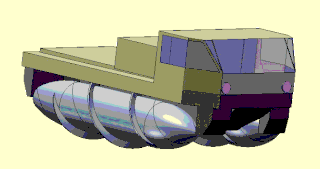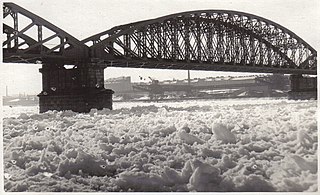
A hovercraft, also known as an air-cushion vehicle or ACV, is an amphibious craft capable of travelling over land, water, mud, ice, and other surfaces.

An amphibious vehicle is a vehicle that is a means of transport viable on land as well as on or under water. Amphibious vehicles include amphibious bicycles, ATVs, cars, buses, trucks, railway vehicles, combat vehicles and hovercraft.

An icebreaker is a special-purpose ship or boat designed to move and navigate through ice-covered waters, and provide safe waterways for other boats and ships. Although the term usually refers to ice-breaking ships, it may also refer to smaller vessels, such as the icebreaking boats that were once used on the canals of the United Kingdom.
A quartz crystal microbalance (QCM) measures a mass variation per unit area by measuring the change in frequency of a quartz crystal resonator. The resonance is disturbed by the addition or removal of a small mass due to oxide growth/decay or film deposition at the surface of the acoustic resonator. The QCM can be used under vacuum, in gas phase and more recently in liquid environments. It is useful for monitoring the rate of deposition in thin-film deposition systems under vacuum. In liquid, it is highly effective at determining the affinity of molecules to surfaces functionalized with recognition sites. Larger entities such as viruses or polymers are investigated as well. QCM has also been used to investigate interactions between biomolecules. Frequency measurements are easily made to high precision ; hence, it is easy to measure mass densities down to a level of below 1 μg/cm2. In addition to measuring the frequency, the dissipation factor is often measured to help analysis. The dissipation factor is the inverse quality factor of the resonance, Q−1 = w/fr ; it quantifies the damping in the system and is related to the sample's viscoelastic properties.

Baku was one of six Leningrad-class destroyer leaders built for the Soviet Navy during the 1930s, one of the three Project 38 variants. Completed in late 1939, the ship was assigned to the Pacific Fleet. About a year after the German invasion of Russia in June 1941, she was ordered to join the Northern Fleet, sailing through the Arctic Ocean. Together with several other destroyers, Baku left the Soviet Far East in July 1942 and arrived off Murmansk three months later where she began escorting convoys, mostly in the White and Barents Seas. The ship was badly damaged in a storm that sank another Soviet destroyer in November and was under repair for several months. Baku spent most of the rest of the war on convoy escort duties, although she did bombard several German-occupied towns during the Petsamo–Kirkenes Offensive of October 1944. The ship and her crew were awarded the Order of the Red Banner in early 1945 for their performance during the war.

Mechanical resonance is the tendency of a mechanical system to respond at greater amplitude when the frequency of its oscillations matches the system's natural frequency of vibration closer than it does other frequencies. It may cause violent swaying motions and potentially catastrophic failure in improperly constructed structures including bridges, buildings and airplanes. This is a phenomenon known as resonance disaster.

A screw-propelled vehicle is a land or amphibious vehicle designed to cope with difficult terrain, such as snow, ice, mud, and swamp. Such vehicles are distinguished by being moved by the rotation of one or more auger-like cylinders fitted with a helical flange that engages with the medium through or over which the vehicle is moving. They have been called Archimedes screw vehicles by the US military, where they are classified as a type of marginal terrain vehicle (MTV). Modern vehicles called Amphirols and other similar vehicles have specialised uses.

An ice road or ice bridge is a human-made structure that runs on a frozen water surface. Ice roads are typically part of a winter road, but they can also be simple stand-alone structures, connecting two shorelines. Ice roads may be planned, built and maintained so as to remain safe and effective, and a number of guidelines have been published with information in these regards. An ice road may be constructed year after year, for instance to service community needs during the winter. It could also be for a single year or two, so as to supply particular operations, such as a hydroelectric project or offshore drill sites.

Ice jams occur when a topographic feature of the river causes floating river ice to accumulate and impede further progress downstream with the river current. Ice jams can significantly reduce the flow of a river and cause upstream flooding—sometimes called ice dams. Ice jam flooding can also occur downstream when the jam releases in an outburst flood. In either case, flooding can cause damage to structures on shore.

The icebreaker Fyodor Litke was active in the Soviet era in the Arctic, until the late 1950s. It was built in 1909 in England for the Saint Lawrence River service and initially named CGC Earl Grey after Albert Grey, Governor General of Canada. After four years in Canada it was sold to the Russian government and eventually renamed Fyodor Litke in honour of the Arctic explorer Fyodor Petrovich Litke.

A mechanical filter is a signal processing filter usually used in place of an electronic filter at radio frequencies. Its purpose is the same as that of a normal electronic filter: to pass a range of signal frequencies, but to block others. The filter acts on mechanical vibrations which are the analogue of the electrical signal. At the input and output of the filter, transducers convert the electrical signal into, and then back from, these mechanical vibrations.
A double acting ship is a type of icebreaking ship designed to travel forwards in open water and thin ice, but turn around and proceed astern (backwards) in heavy ice conditions. In this way, the ship can operate independently in severe ice conditions without icebreaker assistance but retain better open water performance than traditional icebreaking vessels.

Infragravity waves are surface gravity waves with frequencies lower than the wind waves – consisting of both wind sea and swell – thus corresponding with the part of the wave spectrum lower than the frequencies directly generated by forcing through the wind.

The Vityaz DT-30 is a multi-purpose articulated tracked carrier developed in the Soviet Union. It was designed to carry heavy loads in difficult terrain like swamps, sand and snow in extreme weather conditions.

Viktor Mikhailovich Kozin is a Russian naval engineer, ship designer and inventor of a new method of icebreaking, called the resonance method of ice destruction. He received his assistant professorship in technical sciences (PhD) for his work Mechanics of deformable solids in Vladivostok in 1994. He became a full professor in 1996 and was awarded the title Honored Inventor of the Russian Federation in 2000. Since 2008 he has been a member of the Russian Academy of Natural Sciences (RANS).
The index of physics articles is split into multiple pages due to its size.

Murmansk is a Russian Project 21900M diesel-electric icebreaker. While her construction was contracted to Vyborg Shipyard in Russia, she was built at Arctech Helsinki Shipyard in Finland and delivered to Rosmorport in 2016.

Novorossiysk is a Russian Project 21900M diesel-electric icebreaker. She was built by Vyborg Shipyard in Russia and delivered to Rosmorport in 2016.

Tbilisi was one of six Leningrad-class destroyer leaders built for the Soviet Navy during the 1930s, one of the three Project 38 variants. Completed in 1940, the ship was assigned to the Pacific Fleet, with which she spent World War II. Tbilisi laid minefields outside Vladivostok early in the war and during the Soviet–Japanese War transported naval infantry in preparation for an amphibious landing in Korea. Postwar, she continued to serve with the Pacific Fleet and began a lengthy overhaul in 1951 that lasted until 1955. Converted into a target ship in 1958, she was finally struck from the Navy List in 1964 and scrapped.
Ocean development refers to the establishing of human activities at sea and use of the ocean, as well as its governance.













